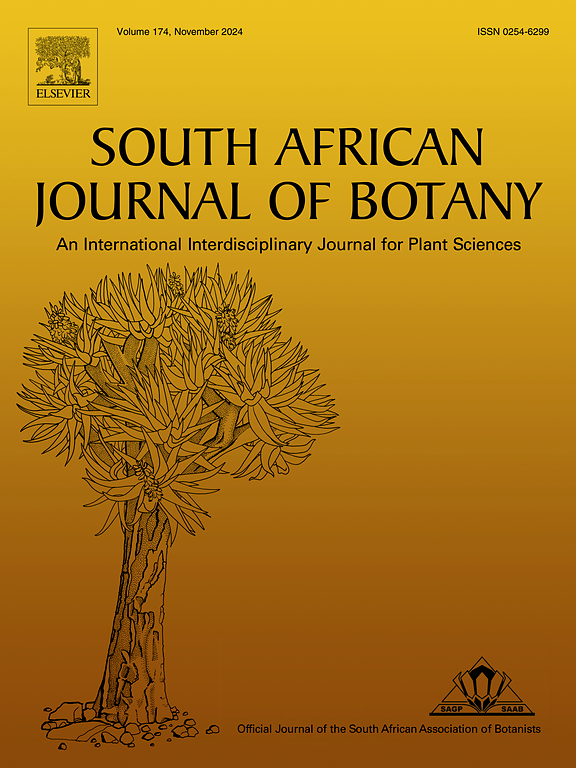玫瑰香天竺葵(Pelargonium graveolens L′Herit ex Aiton)与季节性粮食作物在间作系统中的空间安排可提高土地生产力、生物效率和经济收益
IF 2.7
3区 生物学
Q2 PLANT SCIENCES
引用次数: 0
摘要
天竺葵科天竺葵属植物玫瑰香天竺葵(Pelargonium graveolens L′Herit ex Aiton)也是一种无性繁殖(通过根茎切割)的高价值芳香作物。精油被广泛用于香料、芳香疗法、香精和制药行业。但是,由于土地有限,玫瑰香天竺葵的单一种植会与其他季节性粮食作物形成竞争。间作是一种可持续的方法,通过最大限度地利用现有资源,提高单位土地面积和时间的产量。这项工作旨在研究玫瑰香天竺葵与伴生季节性粮食作物在间作系统中的有效性,以提高产量、玫瑰香天竺葵精油的质量以及农民的经济收益。试验采用随机区组设计,连续两年进行,将玫瑰香天竺葵与玉米(S1)、向日葵(S2)、绿豆(S3)、秋葵(S4)、洋葱(S5)和芸豆(S6)等时令粮食作物按其推荐的种植株数进行间作,并以其单作作为对照。结果表明,S4+G2(秋葵 + 玫瑰香天竺葵,45 × 45)的新鲜药草产量(21.36 吨/公顷)和油产量(35.57 公斤/公顷)最高。同样,S4+G2(秋葵 + 玫瑰香天竺葵,G2)的货币收益(4520 美元/公顷)最高,其次是 S4+G1 和 S3+G2。与单作相比,S4+G2(秋葵+玫瑰香天竺葵 G2)的总土地当量比(2.28)、面积时间当量比(1.72)和土地利用效率(3.14)都更高。在所有间作处理中,玫瑰香天竺葵精油的质量都很好,可被市场接受。因此,间作系统将有助于提高高价值精油的产量,为季节性粮食种植者带来更多利益,同时也有助于芳香产业的发展。本文章由计算机程序翻译,如有差异,请以英文原文为准。
Spatial arrangements of rose-scented geranium (Pelargonium graveolens L′Herit ex Aiton) with seasonal food crops in intercropping system ameliorate the land productivity, biological efficiency and economic returns
Rose-scented geranium (Pelargonium graveolens L′Herit ex Aiton) family, Geraniaceae, is also vegetative propagated (through rooted stem cutting), a high-value aromatic crop. Essential oil is extensively used in the fragrance, aromatherapy, flavor, and pharmaceutical industries. But the cultivation of rose-scented geranium as a monocrop creates competition with companion seasonal food crops in terms of limited availability of land. Intercropping is a sustainable approach to achieve higher production per unit land area and time by maximizing the utilization of available resources. This work was aimed to study the effectiveness of rose-scented geranium with companion seasonal food crops in intercropping system for enhancing the yield, quality of rose-scented geranium essential oil, and monetary gains for farmers. The experiment was conducted in a randomized block design in two successive years, with spatial arrangements of rose-scented geranium at 45 × 30 (G1), 45 × 45 (G2), and 45 × 60 (G3), companion seasonal food crops viz. maize (S1), sunflower (S2), mungbean (S3), okra (S4), onion (S5), and uradbean (S6) at their recommended populations along with their sole crops as a control. The results demonstrated that fresh herb yield (21.36 t/ha) and oil yield (35.57 kg/ha) were recorded maximum under S4+G2 (Okra + Rose-scented geranium at 45 × 45). In a similar manner, the highest monetary gains (4520 USD/ha) were achieved under S4+G2 (Okra + Rose-scented geranium at G2), followed by S4+G1 and S3+G2. The total land equivalent ratio (2.28), area time equivalent ratio (1.72), and land use efficiency (3.14) were higher in S4+G2 (Okra + Rose-scented geranium at G2) over monocrop. The quality of essential oils of rose-scented geranium was good and acceptable for market in all intercropping treatments. Thus, the intercropping system will help to increase high-value essential oil production and provide more benefit to seasonal food growers, as well as help the aroma industry.
求助全文
通过发布文献求助,成功后即可免费获取论文全文。
去求助
来源期刊

South African Journal of Botany
生物-植物科学
CiteScore
5.20
自引率
9.70%
发文量
709
审稿时长
61 days
期刊介绍:
The South African Journal of Botany publishes original papers that deal with the classification, biodiversity, morphology, physiology, molecular biology, ecology, biotechnology, ethnobotany and other botanically related aspects of species that are of importance to southern Africa. Manuscripts dealing with significant new findings on other species of the world and general botanical principles will also be considered and are encouraged.
 求助内容:
求助内容: 应助结果提醒方式:
应助结果提醒方式:


